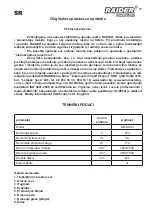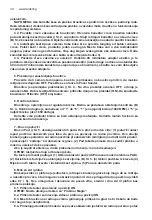
15
This enables the operator to sand the top, middle and bottom of a wall or ceiling joint without
changing his position.
8.1. Turn vacuum cleaner switch ON.
CAUTION: Wear a respirator approved for “Dust and Mist”.
8.2. Turn Drywall Sander switch ON.
8.3. Position Drywall Sander lightly against work surface (apply just enough pressure to
align the sanding head with the work surface).
8.4. Apply additional pressure to engage the abrasive pad to the work surface: while
moving the Sander in an overlapping pattern to smooth the drywall compound down to a
“featheredge”.
Apply ONLY enough pressure to keep the abrasive pad flat against the work. Excessive
pressure can cause unacceptable swirl marks and unevenness in the work surface.
Keep the Sander in constant motion while abrasive pad is in contact with the work surface.
Use a steady, sweeping motion. Stopping the Sander (on the work), or moving the Sander
erratically can cause unacceptable swirl marks and unevenness in the work surface.
NOTE: Do not allow rotating abrasive pad to contact sharp protrusions. Contact with
protruding objects (nails, screws, electrical boxes, etc.), can severely damage the abrasive
pad.
9. ABRASIVE PAD REPLACEMENT
CAUTION: DISCONNECT SANDER FROM POWER SOURCE.
9.1. Grasp the abrasive pad and the sander housing (clamping the pad to the housing), to
prevent pad rotation.
9.2. Rotate the pad retaining nut (A) Fig. 9, counterclockwise and remove.
9.3. Lift off the large metal washer (B) Fig. 9, and the abrasive pad (C) Fig. 9.
NOTE: When the abrasive pad (C) Fig. 9, is lifted off the Sander: the abrasive back-up disc
(A) Fig. 10, is exposed. Please note that this back-up disc is also covered with an abrasive
material. This abrasive material is ONLY used to prevent “slippage” between the back-up
disc and the foam backed abrasive pad, it is NOT suitable for use as a sanding abrasive. DO
NOT USE THE SANDER WITHOUT A PROPER ABRASIVE PAD INSTALLED (to prevent severe
damage to the work).
9.4. Position new abrasive pad to the back-up disc, making sure that the center hole in the
abrasive disc is centered on the hub (B) Fig. 10, of the back-up disc.
9.5. Position the large metal washer (B) Fig. 9, and the retaining nut (A) Fig. 9, to the Sander.
9.6. Rotate the retaining nut clockwise to hand tighten (while holding the abrasive pad as
described in step 1).
10. Disposal.
The machine, accessories and packaging should be sorted for environmental-friendly
recycling. The plastic components are labelled for categorized recycling. Do not dispose of
power tools into household waste! According the European Guideline 2002/96/EC for Waste
Electrical and Electronic Equipment and its implementation into national right, power tools
that are no longer usable must be collected separately and disposed of in an environmentally
correct manner.
Summary of Contents for RD-DS03
Page 3: ...3 Снимките са само с илюстративна цел Може да се различават от закупения от вас модел ...
Page 71: ...71 Exploded drawing of Drywall Sander RD DS03 ...
Page 72: ...72 www raider bg Exploded drawing of Drywall Sander RD DS03 ...
Page 84: ...84 www raider bg ...
Page 89: ...89 ...
Page 91: ...91 ...
















































